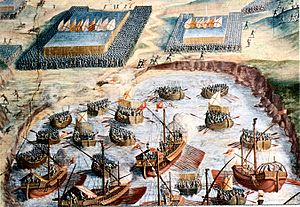War of the Portuguese Succession facts for kids
Quick facts for kids War of the Portuguese Succession |
|||||||||
|---|---|---|---|---|---|---|---|---|---|
| Part of the Portuguese succession crisis of 1580 | |||||||||
 Habsburg tercios landing at the Battle of Ponta Delgada |
|||||||||
|
|||||||||
| Belligerents | |||||||||
|
Supported by
|
|||||||||
| Commanders and leaders | |||||||||
|
|
||||||||
The War of the Portuguese Succession was a fight over who would become the next king of Portugal. It happened between 1580 and 1583. This war started because the Portuguese royal family had no direct heir left.
The last king, Sebastian I of Portugal, died in a battle in 1578. This led to a big problem called the Portuguese succession crisis of 1580. Two main people wanted to be king: António, Prior of Crato, who was supported by many Portuguese towns, and his cousin, Philip II of Spain. In the end, Philip II won and became King of Portugal.
Contents
The Cardinal-King Henry
After King Sebastian died, his great-uncle, Cardinal Henry I of Portugal, became the new ruler. Henry had been a regent for Sebastian since 1557. A regent is someone who rules for a king or queen who is too young or unable to rule.
When Henry became king, he was already an old cardinal, a high-ranking church official. He wanted to get married to have children and continue the royal family line. However, the Pope, Pope Gregory XIII, who was friendly with the Spanish royal family (the Habsburgs), did not let him break his church vows. King Henry died two years later, in 1580, without choosing anyone to take his place.
Who Wanted the Throne?
Many people wanted to be the next King of Portugal. The Portuguese nobles were worried about keeping their country independent. They looked for a new king.
The main people who claimed the throne were:
- Philip II of Spain
- António, Prior of Crato
- Catherine, Duchess of Braganza
- Her nephew, Ranuccio I Farnese, Duke of Parma
Philip II of Spain was a powerful king. His mother was Portuguese, but he was seen as a foreigner. António was a grandson of a former Portuguese king, but he was born outside of marriage. Catherine, Duchess of Braganza, was a Portuguese noblewoman. Her claim was strong because she lived in Portugal and was an adult. However, Portugal had never had a queen rule on her own before. Ranuccio Farnese was an Italian duke and was considered the closest heir by old customs. But his father was an ally of the Spanish King, so his claim was not strongly pushed.

The Main Contenders
Both António and Philip were grandchildren of an earlier Portuguese king, Manuel I of Portugal.
- António was very popular among the common people in Portugal and its growing empire. He had lived in Portugal his whole life. However, his claim was seen as weaker by some because his father was not married to his mother.
- Philip was the oldest grandchild of King Manuel I. His claim was seen as stronger by many nobles and church leaders because his mother was a legitimate princess. Even though he lived mostly in Spain, many powerful people in Portugal supported him.
The War Begins
On July 24, 1580, António declared himself King of Portugal in the city of Santarém. Many people in other towns cheered for him. But he only ruled mainland Portugal for 33 days.
Spanish armies, led by the Duke of Alba, marched into Portugal. On August 25, they defeated António's forces at the Battle of Alcântara. This was a big win for the Spanish. Two days later, the Duke of Alba captured Lisbon, the capital city.
In early 1581, António escaped to France. Philip's armies had not yet taken control of the Azores Islands, which are in the Atlantic Ocean. So, António sailed there with some French adventurers. However, he was completely defeated at sea by a combined Spanish-Portuguese navy. This happened at the Battle of Ponta Delgada in July 1582. António's attempt to rule Portugal from the Azores ended in 1583.
What Happened Next?
The Spanish-Portuguese navy's victory meant Spain quickly took over the Azores. This completed the joining of the Portuguese and Spanish empires. King Philip II of Spain was officially recognized as King Philip I of Portugal in 1581.
In 1589, António tried to take Lisbon again. He had help from English forces, including famous sailors like Sir Francis Drake. But the people of Lisbon did not rise up to support António, so the plan failed.
Spain and Portugal remained united under one king for the next 60 years, until 1640. This period is known as the Iberian Union. During this time, Portugal kept its own government and laws, but it shared the same king as Spain.
Images for kids
See also
 In Spanish: Guerra de sucesión portuguesa para niños
In Spanish: Guerra de sucesión portuguesa para niños


